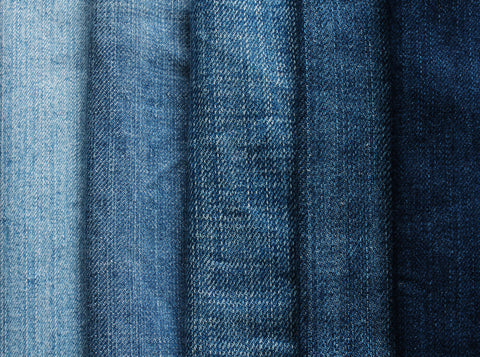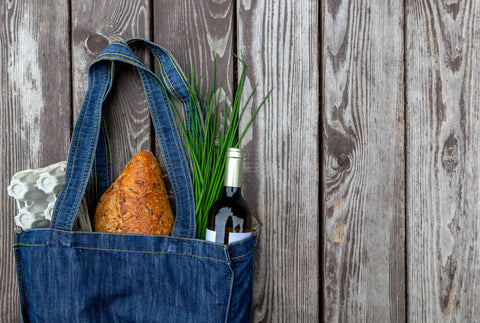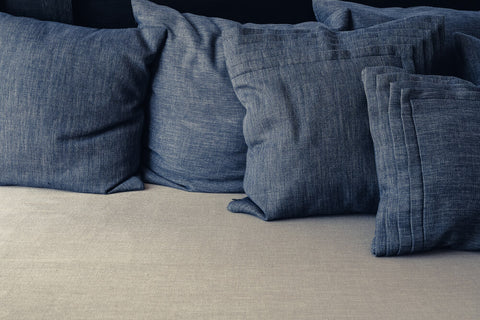
What Is Denim Fabric?
Denim is an extremely versatile fabric made from cotton fibres using a twill weave fabrication method. This type of fabrication gives denim it's signature diagonal ribbing which makes this type of fabric easily recognisable.
Although denim fabric is often associated with clothing items such as jeans and jackets, it actually has a wide portfolio of use cases and can be used to achieve stunning fashion results.
What Is Denim Fabric Used For?
Originally, denim was created to be used in jeans as practical workwear. However, over the years denim fabric has moved away from solely being used as a practical fabric for workwear but has now become a multipurpose fabric with wide use cases such as clothing accessories, and furniture to name a few.
With new development in the fabrication process of denim, it has increasingly become a staple material to create a wide range of products.
What Can I Make With Denim Fabric?
With the ever-expanding use case of denim fabrics, the list of products that can be made from them is practically endless. From durable denim jeans and jackets to more obscure items like denim tote bags, shirts and even sunglasses.
It is also common to find denim material being used in upholstery as well - such as sofas and cushion covers - this is mainly due to its increasing popularity for upcycling as a result of its superior durability.

There are many creative uses for upcycled denim fabrics.
What Does Denim Fabric Feel Like?
Denim tends to feel quite stiff and hard as a material -which is a testament to its durability and quality. However, with a bit of wear and breaking in denim fabric typically begins to soften up and become a lot more comfortable.
There are also lighter variants of denim fabrics that are softer and wear faster to achieve a more comfortable fit, exactly to your liking.
Characteristics, Properties & Advantages Of Denim
Denim, the rugged fabric that's been a wardrobe staple for generations, holds a unique position in the world of fashion, with no other material quite managing to strike the perfect balance between durability and quality.
With this in mind, here is a quick view into the advantages and disadvantages of denim fabrics.
| ✓ | X | |
|---|---|---|
| Durable | May be uncomfortable to wear in the summer | |
| Value for money |
|
|
| Versatile | Low quality denim can experience discolouration | |
| Wrinkle-resistant look | Low quality denim can release and stain with their dye | |
| Effortless styling options | ||
| Maintains shape | ||
| Thick | ||
Different Types Of Denim Fabrics
Despite the similar look of denim, the subtle variations in its texture and colour typically occur during the manufacturing process, making each piece unique.
Discover each type of denim fabric below:
- 100% cotton denim - This is the original denim fabric and is made from 100% cotton. This is what many original workwear jeans were made from.
- Washed denim - Washed denim is washed after the dying process to mitigate the risk of shrinkage and colour bleeding. This is how most commercial denim fabrics are sold.
- Raw denim - In contrast to washed denim, raw or unwashed denim is when the fabric is not washed after the dying process. This often gives a stiff and hard touch to denim.
- Stretch denim - This type of denim is often made by blending denim with synthetic materials including elastane and lycra that give the material a stretchy feel, whilst still able to maintain its shape.
- Bull denim - Frequently used for upholstery, Bull denim has a 3*a twill construction making it strong and extremely durable.
- Coloured denim - This is when denim fabrics undergo different dying processes to achieve certain colours. Such as blue denim is created using indigo dying.
-
Acid-washed denim - Using an aggressive bleaching technique, acid-washed denim fabrics have a more faded dye look.

Denim fabric is becoming a popular upholstery material to add creativity to your living space.
Similar, Alternative Fabrics To Denim
Although chambray fabrics are not denim, they are often mistaken for lightweight denim due to their similar appearance. The difference between the two materials is in the construction process of the fabric. Chambray fabric is made with a plain weave whereas denim is created using a twill weave, giving it a rougher texture.
If you’re looking for a lightweight and arguably more ‘comfortable’ material then chambray fabric might be the next best thing.
Is Denim Fabric Eco-Friendly?
Denim, a fabric with a rich history and timeless appeal, has a dark side: it's notorious for being one of the most environmentally damaging materials to produce. The culprit? Cotton. The use of harmful fertilizers and pesticides in cotton farming, coupled with water-intensive production, makes denim a resource-heavy textile.
A single pair of non-organic cotton denim jeans typically requires upwards of 1,800 gallons of water to produce.
Although this isn’t great news - it's not all bad. Denim fabrics can be considered eco-friendly as good quality denim is typically a material that will last for years to come. This could reduce how often shoppers are replacing denim products that are high-quality and in turn minimise a shopper’s contribution to land-fill.
Likewise, due to traditional denim production, many manufacturers have opted for new technologies for making denim fabrics. This new contemporary denim fabric requires less water, fewer chemicals and less energy making it a far more sustainable production process.
FAQs
What is denim fabric made of?
Denim fabric is typically made from cotton fibres that are woven together in a twill pattern, which gives the fabric it's signature diagonal ribbing.
How is denim fabric dyed?
Denim fabric is traditionally dyed using indigo, a plant-based dye that creates a deep, rich blue colour. The dye is applied in a series of dips, allowing the colour to gradually build up on the fabric.
How can I care for my denim fabric to make it last longer?
To extend the life of your denim fabric, it's best to wash it infrequently, using cold water and mild detergent. Avoid using bleach or fabric softeners, and hang or lay flat to dry rather than using a dryer.
How has denim fabric evolved over time?
Denim fabric has evolved significantly since its invention in the late 1800s, with advancements in dyeing techniques, weaving technology, and fabric blends. Today, denim comes in a variety of washes, finishes, and colours, and is used in a wide range of fashion styles and trends.
A Brief History Of Denim Fabric
The birthplace of denim may be a topic up for debate, but one theory points to Nîmes, France as its origin. Legend has it that tailors in this city stumbled upon a revolutionary technique in the late 1800s, weaving the weft under multiple warped threads to produce a fabric that was both durable and distinct.
This technique gave birth to what we now know as denim, a fabric that has become a cultural icon and a cornerstone of fashion around the world.


